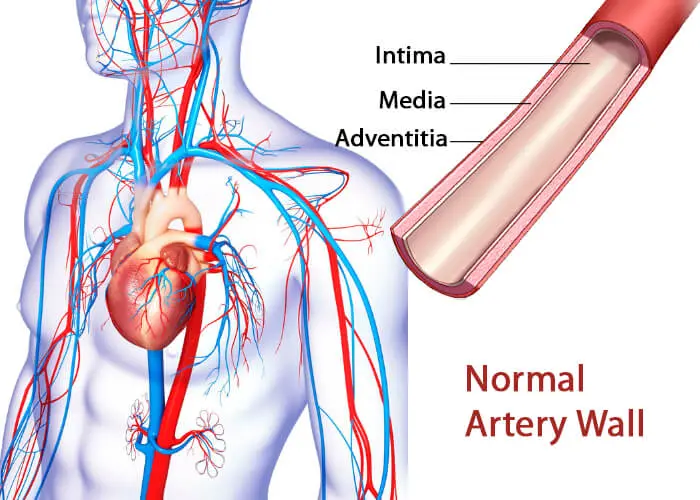A heart attack is scary. At a certain age, we often may wonder, “Am I at risk of having a heart attack?”
Knowledge is power. Knowing if you possess one or more risk factors will help you manage them better and can reduce the chances of having a heart attack.

Heart and blood vessel disease, also called coronary artery disease (CAD), is a condition that occurs from a buildup of fatty deposits in the arteries supplying heart. This fatty deposit buildup in the arteries is also called atherosclerosis. When the arteries are blocked and flow of the blood to the heart is affected it may lead to heart attack.
What are risk factors for a heart attack?
High blood pressure
High blood pressure, or hypertension, is often called “the silent killer” due to a lack of obvious signs and symptom. High blood pressure is a source of many health problems, one of which is an increased risk of heart attack.
Increased pressure in the arteries makes them taught, hard, and narrow, potentially setting the stage for a heart attack. Higher blood pressure makes the heart work harder, which may also contribute to a heart attack. Another cause that can add to the risk of high blood pressure is plaque formation (fatty deposits) at the site of a damaged artery resulting from increased pressure.

High bad cholesterol and low good cholesterol
Chronic inflammatory changes occurring in our blood vessels can cause plaque (fatty deposits) to form within the inner layer of the artery. This is a slow process which may start in childhood and worsen with age. Low density lipoprotein cholesterol (LDL-C), known as bad cholesterol, accumulates in the inner layer of the arteries which surround the open cavity or the lumen of the artery. This cholesterol contributes to the start and progression of plaque formation.
Low levels of good cholesterol, also called high density lipoprotein cholesterol (HDL-C), is associated with an increased risk of heart attack. The cause of this is not yet fully known.
Diabetes mellitus or glucose intolerance
Elevated blood sugar levels and increased insulin resistance are associated with an increased risk of fatty deposit formation in the arteries which may eventually lead to a heart attack. Additional associated risk factors – high cholesterol, obesity, high blood pressure is prevalent in people with diabetes, which further contributes to the risk.
Cigarette smoking
Based on studies conducted on heart attack risks, the incidence of heart attack is increased sixfold in women and threefold in men who smoke at least 20 cigarettes per day, compared with people who never smoked.
A separate study conducted also observed that the risk for recurrent heart attacks in smokers fell 50 percent within one year of smoking cessation. Within 2 years, the risk was equal to that of nonsmokers.
Being overweight or obese
Being overweight or obese are not only risks for a heart attack, but also for other conditions that can elevate the risk of a heart attack, such as diabetes, high blood pressure, high triglycerides, and low level of good cholesterol (HDL-C).
Family history of heart and blood vessel disease (coronary artery disease)
The risk is increased if a family member (biological parent or sibling) has a history of a heart attack or atherosclerosis. The risk is greater if the family member either has atherosclerotic heart disease or died from it prior to 55 years old in males or 65 years old in females.
Increasing age
Every decade of life, the risk increases for any disease affecting the blood vessels including atherosclerotic heart disease.
Sedentary lifestyle
Lack of any physical activity increases the risk. Exercise has a variety of beneficial effects on the heart, such as elevation in HDL cholesterol (good cholesterol), reduction in blood pressure, lower insulin resistance and weight loss.
Psychological stress
There is a link between psychological stress (for example, depression, anxiety, and anger) and damage to an artery, eventually causing the buildup of fatty deposits (atherosclerosis). Indirect stress may increase the risk through the aggravation of other risk factors, such as smoking, high blood pressure, and lipid metabolism.
Take care of your heart
Live tobacco-free
Do not smoke or use any form of tobacco or nicotine products. Avoid secondhand smoke or vapor.
Control your blood sugar and blood pressure better

Eat a heart-healthy diet
A healthy diet is the best weapon for heart attack prevention. Count your calories and know the number of calories you need to consume to maintain a healthy weight. Your age, physical activity, whether you are trying to gain, lose or maintain weight together determine the appropriate number of calories to consume each day.
Some ways food can lead to a healthier heart
- Replace high calorie foods with a wide variety of vegetables and fruits.
- Choose fiber-rich whole grains. Foods with high fiber are not completely digested in the body and become food for friendly organisms in the gut. In addition, they can improve digestive problems, prevent overeating, and help reduce the risk of heart disease.
- Eat a variety of fish, especially those rich in omega-3 fatty acids, such as salmon, trout, and herring.
- Avoid foods and beverages with added sugars. Read all food labels to check these.
- Cut back on salt, especially if you have high blood pressure. Aim to eat no more than 2,300 milligrams of sodium per day.
- Drink alcohol in moderation.
- If you have low levels of good (HDL) cholesterol, aim to increase the good cholesterol by replacing saturated fatty acids with monounsaturated fatty acids.
| Monounsaturated fatty acids | Saturated fatty acids |
|---|---|
| Healthy fats | Unhealthy fats |
| Lowers bad cholesterol (LDL-C) Help develop and maintain cells in the body | Increase the risk of heart disease and other problems |
| Found in plant foods, such as nuts, avocados, and vegetable oils | Found in fatty meat, cheese, butter, ghee, coconut oil, cocoa butter, lard, and cream |
Be physically active
Regular physical activity raises good cholesterol and maintains a healthy weight. Engage in moderate physical activity at least 150 minutes (about 2 and a half hours) each week after consulting with your doctor. If you are unable to exercise, even incorporating short bursts of activity such as walking up the stairs instead of using elevators, parking further away, and walking a distance can help.

Reduce stress and get quality sleep
Stress can have implications for your heart. Positive self-talk, meditation, yoga, taking breaks and spending time with loved ones all go a long way in reducing stress. Make sure you have good sleep hygiene and get 7-8 hours of good sleep each night.
Get health screenings and manage risk factors with your doctor
Keep all your scheduled appointments with your doctor. Discuss the best times for you to screen for diabetes and high cholesterol. In addition, discuss with your doctor ways to prevent the risk factors, especially if you or a family member have had heart disease.
Lastly, be available for yourself to do and enjoy the things that make you happy. Positive experiences, emotions, and mindset will support you in achieving a healthy lifestyle and preventing risks.


